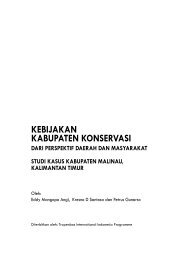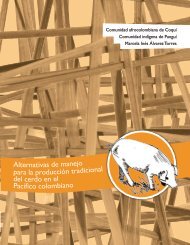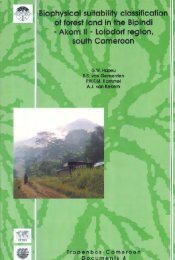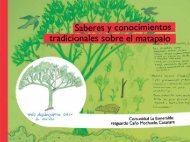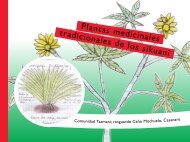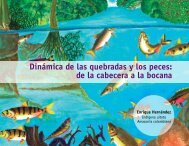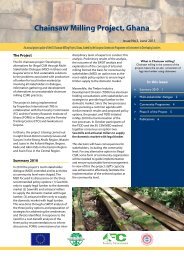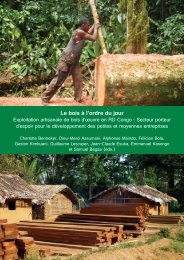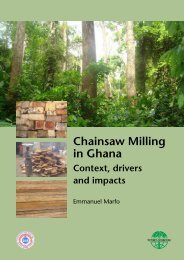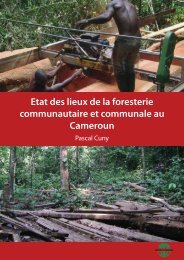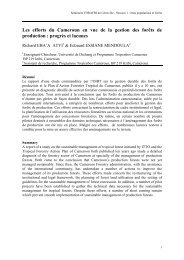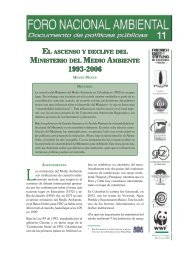Download the publication - Tropenbos International
Download the publication - Tropenbos International
Download the publication - Tropenbos International
You also want an ePaper? Increase the reach of your titles
YUMPU automatically turns print PDFs into web optimized ePapers that Google loves.
Bio-indicator species and Central African rain forest refuges<br />
(Reynaud-Farrera et al., 1996; Muloko-Ntoutoume et al., 1998; Maley, 2002). In <strong>the</strong><br />
same period, <strong>the</strong> rainfall suddenly became more seasonal, thus resulting into an<br />
abrupt expansion of savanna and open vegetation types that may have favoured <strong>the</strong><br />
development of pioneer species. Therefore, when wetter conditions favourable to a<br />
new expansion of <strong>the</strong> forest returned, logically we expect Okoumé, which is a light<br />
demanding species with an excellent dispersal ability, to gain ground in <strong>the</strong><br />
expansion process in preference to <strong>the</strong> lowland evergreen rain forest species.<br />
However, Okoumé has not been successful to expand fur<strong>the</strong>r north towards lake<br />
Ossa because <strong>the</strong> lowland evergreen rain forest species formed a "barrier" against its<br />
expansion.<br />
The climatic fluctuations that occurred in <strong>the</strong> Central Africa region may have<br />
contributed to slow down <strong>the</strong> expansion of Okoumé, as well as that of many species<br />
that reach <strong>the</strong>ir nor<strong>the</strong>rn limit of distribution in <strong>the</strong> Campo-Ma’an area, to progress<br />
fur<strong>the</strong>r north beyond <strong>the</strong> Sanaga River. In Gabon, <strong>the</strong>re is an equatorial climate with<br />
a pronounced dry season that occurs from June/July to August or September. During<br />
this period, <strong>the</strong> sky is often clouded causing a limited evaporation and a low<br />
temperature (Reitsma, 1988). There is a climatic transition around 3°N and <strong>the</strong><br />
Campo-Ma’an area falls within a transitional zone where <strong>the</strong> typical equatorial<br />
climate shifts from a maritime type with 4 seasons, to a “pseudo-tropical type”, with<br />
only two seasons in <strong>the</strong> nor<strong>the</strong>rn coastal region around Douala (Gartlan, 1992;<br />
Maley & Elenga 1993). Therefore, in order to explain <strong>the</strong> suggested past occurrence<br />
of Okoumé around lake Ossa, some authors argue that an equatorial climate must<br />
have reigned over south Cameroon during mid Holocene (Maley, 2002). However,<br />
in <strong>the</strong> Campo-Ma’an area, we have noticed that Okoumé is struggling to expand<br />
fur<strong>the</strong>r north of its present range of distribution under <strong>the</strong> present climatic<br />
conditions. But this expansion is called to a halt because <strong>the</strong> species is unable to<br />
establish under <strong>the</strong> closed canopy of <strong>the</strong> Caesalpinioideae forest as it needs open<br />
habitats to regenerate. In our opinion, <strong>the</strong> unfavourable natural regeneration<br />
conditions are probably <strong>the</strong> main reason for <strong>the</strong> limited occurrence of Okoumé in<br />
Cameroon. So far, in Campo-Ma’an area, Okoumé is only found ei<strong>the</strong>r in mixed<br />
evergreen and semi-deciduous forest with discontinuous canopy or in atypical<br />
habitats as on exposed hill slopes.<br />
4.5. CONCLUSION<br />
This study added some evidence in support to <strong>the</strong> view that <strong>the</strong> Campo-Ma’an area<br />
forms part of a series of postulated tropical rain forest refuges in Central Africa. The<br />
distributions of 178 bio-indicator taxa selected on <strong>the</strong> basis of <strong>the</strong>ir life strategy,<br />
endemism and/or growth forms show a pattern that roughly coincides with a glacial<br />
forest refuge in south-western Cameroon as proposed by several authors. Overall,<br />
<strong>the</strong>re was a high concentration of narrow endemic and bio-indicator species in <strong>the</strong><br />
National Park and in <strong>the</strong> Kribi-Campo-Mvini areas, and a relatively low<br />
concentration of <strong>the</strong>se species in <strong>the</strong> Ma’an area. These bio-indicator species were<br />
mostly found in <strong>the</strong> lowland evergreen forest rich in Caesalpinioideae, on high<br />
altitude lowland rain forests (especially along <strong>the</strong> upper slopes of hills near <strong>the</strong> top)<br />
or along riverbanks. However, it should be noted that <strong>the</strong>se patterns in species<br />
richness are also <strong>the</strong> result of past and present climatic changes, abiotic factors,<br />
biological interaction, ecosystem dynamics, and regional and evolutionary<br />
79



